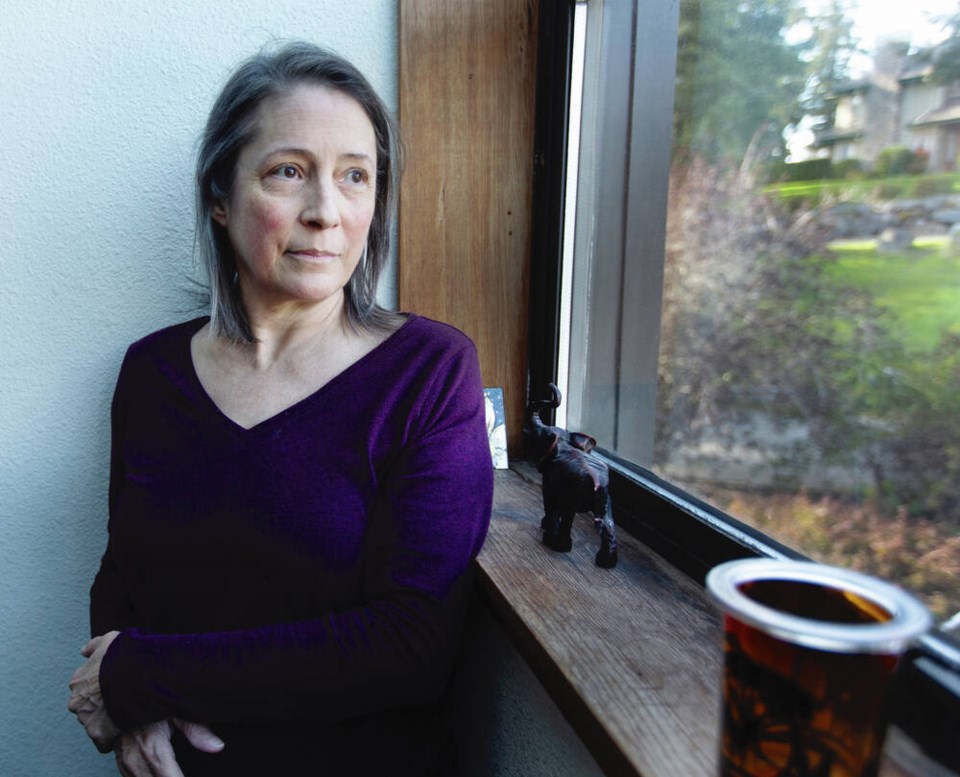Alana Bown is convinced she would be dead if it weren’t for a new liver clinic in Victoria, the only one of its kind in B.C.
Bown, 56, who lives in Saanich, had liver and kidney failure diagnosed after she used alcohol for years as a way to cope with a bad relationship. It landed her in hospital for five months last year. Even after she was discharged, her odds weren’t good.
Then Bown was referred to the new Island Health Liver Care Clinic at Royal Jubilee Hospital. Today, she’s down to three medications from 15, she’s walking unassisted, and she has gained a healthy 50 pounds, up from 90. She credits the clinic for the turnaround.
“I’d either be in the hospital fighting for my life, or I wouldn’t be here — I mean, there’s just no two ways about that,” she said.
Leaders of the new clinic say it’s reducing hospital admissions and deaths. “We were seeing patients who were being re-admitted to hospital time and time again, often visiting the emergency department three or four times before they could be seen by a gastrointestinal specialist,” said Dr. Jeremy Murray-Guenther.
After the idea of the clinic was hatched about six years ago, gastroenterologist Dr. Rohit Pai, who specializes in hepatology, and general internists Murray-Guenther and Dr. Brian McArdle formed a team to develop it.
It became timely during the pandemic as physicians tried to find ways to keep more people out of hospital and was green lit by Island Health as a pilot last year.
The liver clinic is staffed by two internal medicine physicians, a nurse, social worker and dietitian who offer everything from medications to alcohol-abstinence and diet counselling, home health monitoring and end-of-life care.
Nurse clinician Rozalyn Milne said the clinic aims to see patients within two weeks of a referral “and so far we’ve been successful.”
There are different forms of liver disease, but the most common is alcohol-related — drinking and liver-disease admissions rose during the pandemic — followed by non-alcoholic fatty liver disease, which is either hereditary or lifestyle-related.
“With childhood obesity on the rise across Canada, we’re seeing more and more patients with significant liver disease at younger and younger ages not related to alcoholism,” said Pai, noting one in four Canadians has fatty liver disease or risk factors for it.
In some cases of fatty liver disease or symptomatic liver failure, weight loss of just 10 per cent can normalize liver function. Abstinence from alcohol after a few years can see the liver regenerate.
However, 30 to 40 per cent of people with severe liver disease die.
Bown stopped drinking about 18 months ago, but the disease had progressed to the point that she had abscesses on her legs that made it impossible to walk and a lack of organ function meant she couldn’t speak or eat.
On March 26 last year, Bown was found unresponsive on the floor of her Langford apartment by her son, a correctional worker. “I had been without alcohol and cigarettes for three or four months, but I wasn’t feeling well,” said Bown. “That day, I sat on the floor thinking I’m just going to rest for a moment and I don’t remember anything until I became aware I was in hospital two days later.”
About 200 people with acute liver failure are admitted to hospital in Victoria each year. At any given time, the clinic is monitoring about 50 patients with significant liver dysfunction.
In addition to malnutrition, jaundice, confusion and life-threatening internal bleeding, patients with severe liver disease often experience an accumulation of fluid in the abdomen that has to be drained in a hospital, sometimes repeatedly.
Prior to the liver clinic, patients such as Bown were re-admitted through ERs either before they could get in to see a gastroenterologist or after being discharged from hospital, said Pai.
Thirty to 40 per cent of liver disease patients were re-admitted to hospital within 30 days and, of those, 50 per cent died, said Pai. “What we’ve been able to do, essentially, is take that re-admission rate down from 30 to 40 per cent to less than 10 per cent,” over the course of about nine months.
Severe liver-disease patients, many admitted to intensive care, were costing Island Health about $5 million a year; Pai said the clinic is already reducing that by about 20 to 30 per cent.
Murray-Guenther said many clinic patients are getting and staying well “and we’re able to essentially de-escalate their care. This isn’t something we usually see with this form of disease.”
Even for those who won’t survive, the clinic offers a better quality of life and better end-of-life care, Pai said.
The clinic also provides an educational component where medical residents learn about caring for patients with liver disease. It’s an opportunity for specialists to model “non-judgemental and compassionate” care to patients with a disease “that can be highly stigmatized,” said Milne.
Pai said many patients with liver failure feel that they contributed to the condition, and are thus “not worthy of being looked after,” but clinic providers treat with “zero judgment.”
The liver clinic team hopes to expand the model to other areas of the Island and develop partnerships with the Indigenous populations.
On Thursday, Bown turned 56 — a birthday she fears she would have missed had it not been for the clinic.
She becomes emotional when she talks about how fun family dinners are with her grown children, and how much she would have missed if she hadn’t survived.
“The biggest thing is — and I’m going to get all teary again — is I got a chance for all of us to be family again.”
For more information on liver disease go to the Canadian Liver Foundation website at liver.ca or the Cirrhosis Care website at cirrhosiscare.ca.
• To comment on this article, write a letter to the editor: [email protected]



